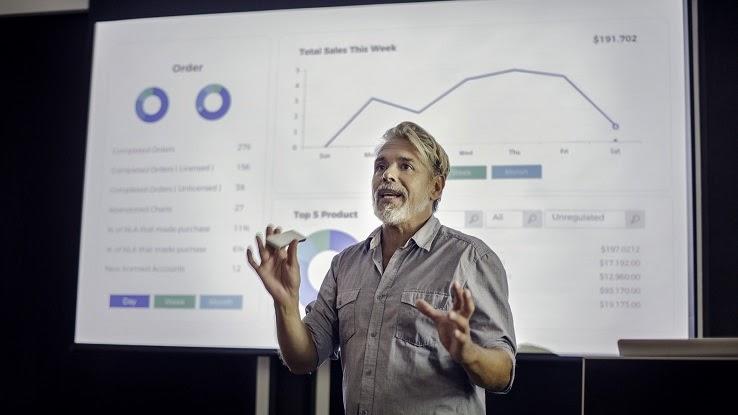What Is the Use of Statistics in Business & Decision Making?

Business statistics compile information about businesses and the industries, consumers and economies that impact them. These statistical data ultimately help guide the administrative decision-making process that determines the directions a company might head in. There are several different types of statistics, but the core concepts of business statistics are descriptive and inferential statistics. These allow for accurate analysis of both the present and the future.
Descriptive statistics use the mathematical concepts of mean, median and mode to reach conclusions about things that are happening right now. This branch of statistics takes the guesswork out of interpreting data because it gives definitive information. Inferential statistics, on the other hand, use the findings from a small set of data to make inferences about a larger set of data. In statistics, this is called sampling because a sample size of a group is used to extrapolate information about the entire group.
Suppose two businesses wanted to find the average ages of their customers. A mortgage lender can use descriptive statistics because loan applications collect ages. The lender can then use those data to find the statistical average age of customers. A clothing store doesn’t ask for customers’ ages when they make purchases, however. To find the average age of customers, the store may need to rely on a survey. If 20,000 out of the store’s 100,000 annual shoppers answer the survey, the results represent 20% of the store’s total population of customers, but this sample of data can be used to estimate the average age of all customers using inferential statistics.
This is just one example of the ways various companies might use statistics to achieve different goals. However, statistics can also play much larger roles in the world of business.
Why Do Businesses Need Statistics?
Mistakes in business can cost millions of dollars, and that’s one key reason why businesses rely on statistics to guide their decision-making processes. Statistics can explain why a past event happened and predict what’s likely to happen in the future. Although statistics aren’t always fail-proof, they can help business leaders produce educated conclusions with much more certainty than they’d achieve by simply relying on the knowledge and opinions of a few people.

Statistical budgets give businesses the power to plan for the unknown. This type of budget uses real data from the past to make reliable estimates about the future. Statistical budgets analyze revenue, operating costs, payroll, cost of goods and other important numbers from the past to draw conclusions that help finance professionals come up with more accurate budgets for future years.
As an example, Capital One and American Express use statistical data to attract new customers. Have you ever noticed how the credit card offers you receive in the mail seem to fit well with your current financial needs? This isn’t necessarily a coincidence. Credit card companies have access to the demographic data and spending habits of millions of people. They compile all of these data into meaningful statistics that infer what similar people likely need credit for. Then, these companies advertise strategically to meet the needs of different consumers in their current life situations.
Statistics in Business and Economics
Statistics are also a very important element of economics. Every business is part of the economy. Keen businesses keep a close eye on economic trends to determine how these may impact their industries overall.

Analysts can use statistical signs to predict recessions, which have a major impact on the economy. Statisticians watch the yield curve of the interest rates that the U.S. Treasury sets on bonds; this plot shows the different maturity dates of those bonds over time. An upside-down yield curve is a bad sign because it means younger bonds are yielding more interest than older ones, which goes against common convention and may signal a downturn in the market.
Opinions can also be important statistics to watch. Polls, such as the NFIB Small Business Optimism Index, ask consumers about their confidence in the economy and their jobs. When consumer sentiments are poor, those people are less likely to spend money. When the national unemployment rate increases, this is also a strong indicator of an economic recession.
When businesses notice these signs, they can plan for the future to ensure their own longevity. Recessions often mean less revenue and higher expenses for businesses. Savvy businesses work to decrease expenses — sometimes by cutting back on marketing, selling excess capital or reducing staff — at the first signs of an impending recession. To prepare for a recession, businesses also make decisions to earn the confidence of employees and customers. In response to the 2008 recession, for example, Hyundai allowed customers who had lost their jobs to return new cars up to a year after purchasing them. This is an example of a company acting in good faith in a way that ultimately built brand loyalty.
New Hanover Regional Medical Center is a healthcare system in Southeastern North Carolina that used statistics to make proactive decisions. The hospital started as a small county hospital in the 1950s. Now, it includes multiple campuses, regional physicians’ offices and a variety of specialty centers.
Decision-makers within the healthcare system used statistics to determine that current facilities and capital would not be sufficient to serve the region’s rapidly growing population in the next decade. Rather than waiting until money ran out and hospitals grew unable to serve patients, the hospital sought options for getting more capital and space in the future. The decision was made to merge the large hospital with Novant Health and the UNC School of Medicine. Now, the facility will have the capital and educational resources to meet the needs of the growing community over the next several decades.
The Role of Statistics in Small Business
Large corporations often use expensive software and the world’s best statisticians to come up with statistical data. Small businesses can benefit just as much from statistics, but they often lack the financial means for large studies that are advantageous to large businesses.

Small businesses can get plenty of statistics without breaking the bank. Accounting services and software programs have reporting features that do automatic statistical reports on financial data. Social media platforms like Facebook and Instagram also offer free statistics and reports for any business account, and these can quantify customers’ reactions to certain messages.
Small business owners can also take advantage of data that are available to everyone via various government and private sector organizations that release statistical information to the public. A few are the Small Business Administration, the U.S. Treasury and the Bureau of Labor Statistics. These data can help small business owners identify trends in the industry and the economy.





